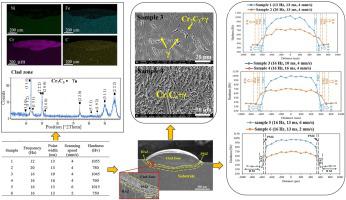当前位置:
X-MOL 学术
›
J. Mater. Process. Tech.
›
论文详情
Our official English website, www.x-mol.net, welcomes your
feedback! (Note: you will need to create a separate account there.)
Microstructural evolution of laser-clad 75Cr3C2+25(80Ni20Cr) powder on Inconel 718 superalloy
Journal of Materials Processing Technology ( IF 6.7 ) Pub Date : 2020-10-01 , DOI: 10.1016/j.jmatprotec.2020.116735 Ali Khorram , Akbar Davoodi Jamaloei , Abed Jafari , Moslem Paidar , Xinjin Cao
Journal of Materials Processing Technology ( IF 6.7 ) Pub Date : 2020-10-01 , DOI: 10.1016/j.jmatprotec.2020.116735 Ali Khorram , Akbar Davoodi Jamaloei , Abed Jafari , Moslem Paidar , Xinjin Cao

|
Abstract Nickel-based superalloys such as Inconel 718 are widely used in the aerospace industry. The surface properties of Inconel 718 can be improved by the addition of chromium carbide–nickel chromium powder. In this study, 75Cr3C2+25(80Ni20Cr) powder was clad on annealed Inconel 718 superalloy by using a pulsed Nd:YAG laser. The aim of this research is to investigate the effect of laser process parameters such as pulse width, laser frequency and scanning speed on the microstructure and microhardness of the clad samples. It is found that the increasing pulse width and laser frequency or decreasing scanning speed can increase the heat input and the resultant dilution ratio. The clad zone of the samples with a high dilution ratio consists of eutectic structure (γ and Cr7C3). However, the clad zone of specimens with a low dilution ratio is composed of a hypereutectic structure of Cr7C3+(γ+Cr7C3). This microstructure leads to the significant increase in the hardness value in comparison with the specimens with a high dilution ratio, due to the presence of proeutectic Cr7C3 carbides in the hypereutectic structure. The maximum hardness value of the clad zone is found to increase almost 2.5 times that for the substrate in the annealed condition. However, the austenitic and Laves phases are formed in the partially mixed zone. This zone is rather narrow, approximately 30 μm. The grain coarsening occurs in the heat-affected zone of all the deposited specimens. The hardness values of the partially mixed and heat-affected zones are lower than that for the clad zone.
中文翻译:

Inconel 718高温合金上激光熔覆75Cr3C2+25(80Ni20Cr)粉末的显微组织演变
摘要 镍基高温合金如 Inconel 718 广泛应用于航空航天工业。Inconel 718 的表面性能可以通过添加碳化铬-镍铬粉来改善。在本研究中,使用脉冲 Nd:YAG 激光将 75Cr3C2+25(80Ni20Cr) 粉末包覆在退火的 Inconel 718 高温合金上。本研究的目的是研究脉冲宽度、激光频率和扫描速度等激光工艺参数对熔覆样品显微组织和显微硬度的影响。研究发现,增加脉冲宽度和激光频率或降低扫描速度会增加热输入和由此产生的稀释率。高稀释率样品的包覆区由共晶结构(γ和Cr7C3)组成。然而,低稀释比试样的包覆区由Cr7C3+(γ+Cr7C3)过共晶结构组成。由于过共晶组织中存在先共晶 Cr7C3 碳化物,与具有高稀释比的试样相比,这种显微组织导致硬度值显着增加。发现复合区的最大硬度值几乎是退火条件下基材的 2.5 倍。然而,奥氏体相和 Laves 相在部分混合区形成。该区域相当狭窄,大约 30 μm。晶粒粗化发生在所有沉积试样的热影响区。部分混合区和热影响区的硬度值低于复合区的硬度值。由于过共晶组织中存在先共晶 Cr7C3 碳化物,与具有高稀释比的试样相比,这种显微组织导致硬度值显着增加。发现复合区的最大硬度值几乎是退火条件下基材的 2.5 倍。然而,奥氏体相和 Laves 相在部分混合区形成。该区域相当狭窄,大约 30 μm。晶粒粗化发生在所有沉积试样的热影响区。部分混合区和热影响区的硬度值低于复合区的硬度值。由于过共晶组织中存在先共晶 Cr7C3 碳化物,与具有高稀释比的试样相比,这种显微组织导致硬度值显着增加。发现复合区的最大硬度值几乎是退火条件下基材的 2.5 倍。然而,奥氏体相和 Laves 相在部分混合区形成。该区域相当狭窄,大约 30 μm。晶粒粗化发生在所有沉积试样的热影响区。部分混合区和热影响区的硬度值低于复合区的硬度值。由于过共晶结构中存在先共晶 Cr7C3 碳化物。发现复合区的最大硬度值几乎是退火条件下基材的 2.5 倍。然而,奥氏体相和 Laves 相在部分混合区形成。该区域相当狭窄,大约 30 μm。晶粒粗化发生在所有沉积试样的热影响区。部分混合区和热影响区的硬度值低于复合区的硬度值。由于过共晶结构中存在先共晶 Cr7C3 碳化物。发现复合区的最大硬度值几乎是退火条件下基材的 2.5 倍。然而,奥氏体相和 Laves 相在部分混合区形成。该区域相当狭窄,大约 30 μm。晶粒粗化发生在所有沉积试样的热影响区。部分混合区和热影响区的硬度值低于复合区的硬度值。晶粒粗化发生在所有沉积试样的热影响区。部分混合区和热影响区的硬度值低于复合区的硬度值。晶粒粗化发生在所有沉积试样的热影响区。部分混合区和热影响区的硬度值低于复合区的硬度值。
更新日期:2020-10-01
中文翻译:

Inconel 718高温合金上激光熔覆75Cr3C2+25(80Ni20Cr)粉末的显微组织演变
摘要 镍基高温合金如 Inconel 718 广泛应用于航空航天工业。Inconel 718 的表面性能可以通过添加碳化铬-镍铬粉来改善。在本研究中,使用脉冲 Nd:YAG 激光将 75Cr3C2+25(80Ni20Cr) 粉末包覆在退火的 Inconel 718 高温合金上。本研究的目的是研究脉冲宽度、激光频率和扫描速度等激光工艺参数对熔覆样品显微组织和显微硬度的影响。研究发现,增加脉冲宽度和激光频率或降低扫描速度会增加热输入和由此产生的稀释率。高稀释率样品的包覆区由共晶结构(γ和Cr7C3)组成。然而,低稀释比试样的包覆区由Cr7C3+(γ+Cr7C3)过共晶结构组成。由于过共晶组织中存在先共晶 Cr7C3 碳化物,与具有高稀释比的试样相比,这种显微组织导致硬度值显着增加。发现复合区的最大硬度值几乎是退火条件下基材的 2.5 倍。然而,奥氏体相和 Laves 相在部分混合区形成。该区域相当狭窄,大约 30 μm。晶粒粗化发生在所有沉积试样的热影响区。部分混合区和热影响区的硬度值低于复合区的硬度值。由于过共晶组织中存在先共晶 Cr7C3 碳化物,与具有高稀释比的试样相比,这种显微组织导致硬度值显着增加。发现复合区的最大硬度值几乎是退火条件下基材的 2.5 倍。然而,奥氏体相和 Laves 相在部分混合区形成。该区域相当狭窄,大约 30 μm。晶粒粗化发生在所有沉积试样的热影响区。部分混合区和热影响区的硬度值低于复合区的硬度值。由于过共晶组织中存在先共晶 Cr7C3 碳化物,与具有高稀释比的试样相比,这种显微组织导致硬度值显着增加。发现复合区的最大硬度值几乎是退火条件下基材的 2.5 倍。然而,奥氏体相和 Laves 相在部分混合区形成。该区域相当狭窄,大约 30 μm。晶粒粗化发生在所有沉积试样的热影响区。部分混合区和热影响区的硬度值低于复合区的硬度值。由于过共晶结构中存在先共晶 Cr7C3 碳化物。发现复合区的最大硬度值几乎是退火条件下基材的 2.5 倍。然而,奥氏体相和 Laves 相在部分混合区形成。该区域相当狭窄,大约 30 μm。晶粒粗化发生在所有沉积试样的热影响区。部分混合区和热影响区的硬度值低于复合区的硬度值。由于过共晶结构中存在先共晶 Cr7C3 碳化物。发现复合区的最大硬度值几乎是退火条件下基材的 2.5 倍。然而,奥氏体相和 Laves 相在部分混合区形成。该区域相当狭窄,大约 30 μm。晶粒粗化发生在所有沉积试样的热影响区。部分混合区和热影响区的硬度值低于复合区的硬度值。晶粒粗化发生在所有沉积试样的热影响区。部分混合区和热影响区的硬度值低于复合区的硬度值。晶粒粗化发生在所有沉积试样的热影响区。部分混合区和热影响区的硬度值低于复合区的硬度值。











































 京公网安备 11010802027423号
京公网安备 11010802027423号